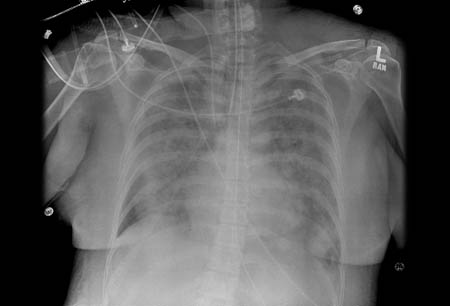Resumo
Definição
História e exame físico
Principais fatores diagnósticos
- ingestão de 150 mg/kg ou mais, ou de 6.5 g ou mais, de aspirina ou equivalente
- ingestão de salicilato de metila (óleo de gaultéria)
- ingestão de subsalicilato de bismuto
- lesão autoprovocada ou tentativa de suicídio
- crianças com 3 ou menos anos de idade e adultos com 70 ou mais anos de idade
- ingestão ou exposição a uma toxina desconhecida
- comportamento anormal
- náuseas, vômitos, hematêmese, dor epigástrica
- febre e diaforese
- dispneia
- taquipneia, respiração de Kussmaul
- zumbido e/ou surdez
- mal-estar e/ou tontura
- distúrbios do movimento, asterixis (flapping), estupor
- confusão e/ou delirium (irritabilidade, alucinações)
- coma e/ou papiledema
- convulsões
- estertores associados a baixa saturação de oxigênio
Outros fatores diagnósticos
- depleção de volume
- erupção cutânea
Fatores de risco
- ingestão de 150 mg/kg ou mais, ou de 6.5 g ou mais, de aspirina ou equivalente
- ingestão de salicilato de metila (óleo de gaultéria)
- ingestão de subsalicilato de bismuto
- história de lesão autoprovocada ou tentativa de suicídio
- crianças com 3 ou menos anos de idade e adultos com 70 ou mais anos de idade
Investigações diagnósticas
Primeiras investigações a serem solicitadas
- gasometria arterial
- painel de eletrólitos séricos
- nível de salicilato sérico
- ureia e creatinina séricas
- cetonas séricas
- glicose sanguínea
- Hemograma completo
- testes séricos da função hepática
- tempo de protrombina (TP) sérico, tempo de tromboplastina parcial (TTP) ativada, razão normalizada internacional (INR)
- análise toxicológica
- radiografia torácica
- eletrocardiograma (ECG)
Investigações a serem consideradas
- ecocardiograma
- tomografia computadorizada (TC) de crânio
- eletroencefalograma (EEG)
Algoritmo de tratamento
assintomático: sem critérios para o encaminhamento ao hospital
assintomático: com critérios para o encaminhamento ao hospital
pacientes sintomáticos
Colaboradores
Autores
Chris Hoyte, MD
Medical Toxicology Fellowship Program Director
Rocky Mountain Poison and Drug Safety
Denver
Professor
Department of Emergency Medicine
University of Colorado School of Medicine
Aurora
CO
Declarações
CH declares that he has no competing interests.
Eric Lavonas, MD, MS
Attending Physician
Department of Emergency Medicine and Rocky Mountain Poison and Drug Safety
Denver Health
Denver
Professor
Department of Emergency Medicine
University of Colorado School of Medicine
Aurora
CO
Declarações
EL is an author of a reference cited in this topic.
Agradecimentos
Dr Chris Hoyte and Dr Eric Lavonas would like to gratefully acknowledge Dr Kathryn A. Koch, a previous contributor to this topic. KAK declares that she has no competing interests.
Revisores
Colin A. Graham, MBChB, MPH, MD, FRCSEd, FRCSGlasg, FIMCRCSEd, FCCP, FCEM, FHKCEM, FHKAM
Editor
European Journal of Emergency Medicine
Professor of Emergency Medicine
Chinese University of Hong Kong
Hong Kong
People's Republic of China
Declarações
CAG is the editor of the European Journal of Emergency Medicine and receives an annual honorarium from Wolters Kluwer Health, the journal's publishers.
Gerald F. O'Malley, DO
Director
Division of Research
Department of Emergency Medicine
Albert Einstein Medical Center
Philadelphia
PA
Declarações
GFOM declares that he has no competing interests.
Paul Wax, MD
Clinical Professor of Surgery (Emergency Medicine)
University of Texas Southwestern Medical Center
Dallas
TX
Declarações
PW is an author of a reference cited in this topic.
Créditos aos pareceristas
Os tópicos do BMJ Best Practice são constantemente atualizados, seguindo os desenvolvimentos das evidências e das diretrizes. Os pareceristas aqui listados revisaram o conteúdo pelo menos uma vez durante a história do tópico.
Declarações
As afiliações e declarações dos pareceristas referem--se ao momento da revisão.
Referências
Principais artigos
Palmer BF, Clegg DJ. Salicylate toxicity. N Engl J Med. 2020 Jun 25;382(26):2544-55. Resumo
Chyka PA, Erdman AR, Christianson G, et al. Salicylate poisoning: an evidence-based consensus guideline for out-of-hospital management. Clin Toxicol (Phila). 2007;45(2):95-131.Texto completo Resumo
American College of Medical Toxicology. Guidance document: management priorities in salicylate toxicity. J Med Toxicol. 2015 Mar;11(1):149-52.Texto completo
Dargan PI, Wallace CI, Jones AL. An evidence based flowchart to guide the management of acute salicylate (aspirin) overdose. Emerg Med J. 2002 May;19(3):206-9.Texto completo Resumo
Artigos de referência
Uma lista completa das fontes referenciadas neste tópico está disponível para os usuários com acesso total ao BMJ Best Practice.

Differentials
- Cetoacidose diabética
- Demência
- Pneumonia
Mais Diagnósticos diferenciaisGuidelines
- Salicylates poisoning
- Salicylate poisoning: an evidence-based consensus guideline for out-of-hospital management
Mais GuidelinesCalculators
Anion gap
More CalculatorsLog in or subscribe to access all of BMJ Best Practice
Use of this content is subject to our disclaimer